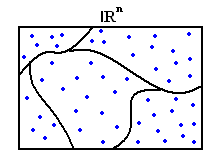| Line 1: | Line 1: | ||
| − | The '''LGB algorithm''' is another clustering technique. It has a slightly different approach compared to [K- | + | The '''LGB algorithm''' is another clustering technique. It has a slightly different approach compared to [[K-means_Old Kiwi]]. In this algorithm the user inputs the number of clusters he wants to split his data set into. It has to be a power of 2. |
| − | The | + | The algorithm works as follows: |
1) Find the sample mean of the data. Let that me some mu. | 1) Find the sample mean of the data. Let that me some mu. | ||
Latest revision as of 00:07, 7 April 2008
The LGB algorithm is another clustering technique. It has a slightly different approach compared to K-means_Old Kiwi. In this algorithm the user inputs the number of clusters he wants to split his data set into. It has to be a power of 2.
The algorithm works as follows:
1) Find the sample mean of the data. Let that me some mu.
2) To this mean add and subtract a small value epsilon. Thus we will have 2 new means mu +epsilon and mu-epsilon.For every data point in the set find which mean it belongs to. Now we have thus clustered the data into 2 parts.
3) For each of this part evaluate the new means. Now again split each of the means into 2 more.
4) Continue till we get the desired number of clusters.
This algorithm will ensure that we have the desired number of clusters.
The algorithm is named after Linde,Buzo and Gray.


